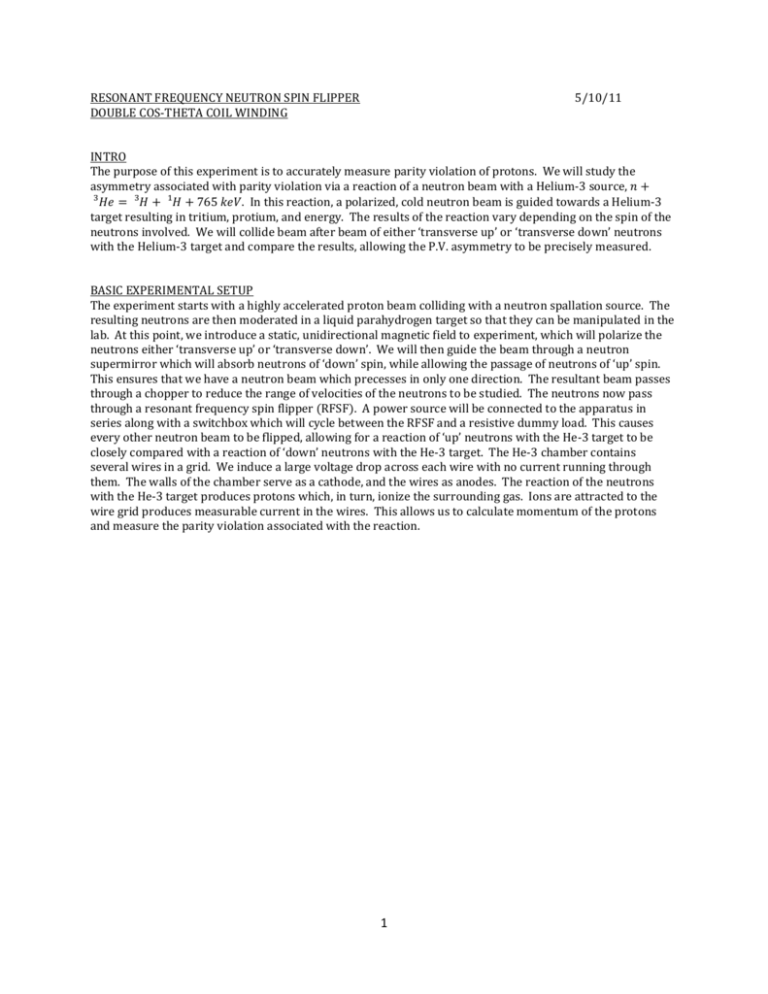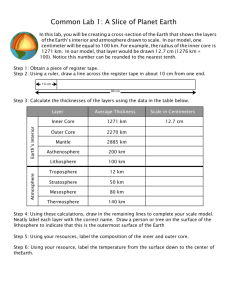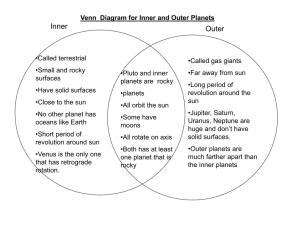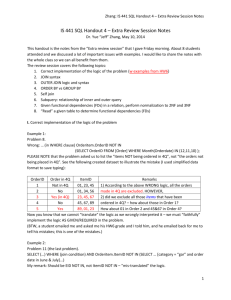tomey_RFSF_report
advertisement

RESONANT FREQUENCY NEUTRON SPIN FLIPPER DOUBLE COS-THETA COIL WINDING 5/10/11 INTRO The purpose of this experiment is to accurately measure parity violation of protons. We will study the asymmetry associated with parity violation via a reaction of a neutron beam with a Helium-3 source, 𝑛 + 3 𝐻𝑒 = 3𝐻 + 1𝐻 + 765 𝑘𝑒𝑉. In this reaction, a polarized, cold neutron beam is guided towards a Helium-3 target resulting in tritium, protium, and energy. The results of the reaction vary depending on the spin of the neutrons involved. We will collide beam after beam of either ‘transverse up’ or ‘transverse down’ neutrons with the Helium-3 target and compare the results, allowing the P.V. asymmetry to be precisely measured. BASIC EXPERIMENTAL SETUP The experiment starts with a highly accelerated proton beam colliding with a neutron spallation source. The resulting neutrons are then moderated in a liquid parahydrogen target so that they can be manipulated in the lab. At this point, we introduce a static, unidirectional magnetic field to experiment, which will polarize the neutrons either ‘transverse up’ or ‘transverse down’. We will then guide the beam through a neutron supermirror which will absorb neutrons of ‘down’ spin, while allowing the passage of neutrons of ‘up’ spin. This ensures that we have a neutron beam which precesses in only one direction. The resultant beam passes through a chopper to reduce the range of velocities of the neutrons to be studied. The neutrons now pass through a resonant frequency spin flipper (RFSF). A power source will be connected to the apparatus in series along with a switchbox which will cycle between the RFSF and a resistive dummy load. This causes every other neutron beam to be flipped, allowing for a reaction of ‘up’ neutrons with the He-3 target to be closely compared with a reaction of ‘down’ neutrons with the He-3 target. The He-3 chamber contains several wires in a grid. We induce a large voltage drop across each wire with no current running through them. The walls of the chamber serve as a cathode, and the wires as anodes. The reaction of the neutrons with the He-3 target produces protons which, in turn, ionize the surrounding gas. Ions are attracted to the wire grid produces measurable current in the wires. This allows us to calculate momentum of the protons and measure the parity violation associated with the reaction. 1 POTENTIAL First, we will solve for the two potentials for of our design. The first, inner potential will lie in the region 𝑠 = 0 to 𝑠 = 𝑎. The second potential will lie in the region 𝑠 = 𝑎 to 𝑠 = 𝐴. Additionally, we will require that the potential outside the two cylindrical shells is zero in all directions. Calculating the potential inside the inner cylinder: ⃑ = −∇𝑈 = − 𝜕 (𝑈) = 𝐻𝑜 𝑥̂ 𝐻 𝜕𝑥 Integrating: −𝑈 = 𝐻𝑜 𝑥 𝑈 = −𝐻𝑜 𝑥 𝑈 = −𝐻𝑜 𝑠𝑐𝑜𝑠𝜙 Calculating the potential between the inner and outer cylinder (solving Laplace’s Eq.): ∇2 U = 0 Note that the solution for potential does not depend on z. 𝑘 −𝑘 𝑈 = 𝑎𝑜 + 𝑏𝑜 ln(s) + ∑∞ 𝑘=1 (𝑎𝑘 𝑠 + 𝑏𝑘 𝑠 )(𝑐𝑘 𝑐𝑜𝑠(𝑘𝜙) + 𝑑𝑘 sin(𝑘𝜙)) General Solution: Boundaries: @ 𝑠 = 𝑎: @ 𝑠 = 𝐴: 𝑈 = −𝐻𝑜 𝑠𝑐𝑜𝑠𝜙 𝑈=0 (i) (ii) Due to boundary conditions, 𝑎𝑜 = 𝑑𝑘 = 0. Also due to boundary conditions, we are only concerned with solutions in which 𝑘 = 1. 𝑈 = 𝑏𝑜 ln(𝑠) + 𝑐1 𝑐𝑜𝑠𝜙(𝑎1 𝑠 + 𝑏1 𝑠 −1 ) Remaining Solution: Let 𝑐1 be absorbed by 𝑎1 and 𝑏1 . 𝑈 = 𝑏𝑜 ln(𝑠) + 𝑐𝑜𝑠𝜙(𝑎1 𝑠 + 𝑏1 𝑠 −1 ) Remaining Solution: Differentiate each side with respect to s and evaluate at each boundary. 𝜕 𝜕 (−𝐻𝑜 𝑠𝑐𝑜𝑠𝜙)|𝑠=𝑎 = [𝑏𝑜 ln(𝑠) + 𝑐𝑜𝑠𝜙(𝑎1 𝑠 + 𝑏1 𝑠 −1 )]|𝑠=𝑎 i) 𝜕𝑠 𝑏𝑜 −𝐻𝑜 𝑐𝑜𝑠𝜙 = [ 𝑠 𝑏𝑜 −𝐻𝑜 𝑐𝑜𝑠𝜙 = [ 𝑎 𝜕𝑠 + 𝑐𝑜𝑠𝜙 (𝑎1 − + 𝑐𝑜𝑠𝜙 (𝑎1 − 𝑏1 )] |𝑠=𝑎 𝑠2 𝑏1 𝑎2 )] Obviously, 𝑏𝑜 = 0 and −𝐻𝑜 = (𝑎1 − ii) 𝜕 𝜕𝑠 (0)|𝑠=𝐴 = 𝜕 𝜕𝑠 𝑎1 = 𝑏1 ) [𝑏𝑜 ln(𝑠) + 𝑐𝑜𝑠𝜙(𝑎1 𝑠 + 𝑏1 𝑠 −1 )]|𝑠=𝐴 0 = [0 + 𝑐𝑜𝑠𝜙 (𝑎1 − 0 = 𝑎1 − 𝑏1 𝑎2 𝑏1 𝑏1 𝑠2 )] |𝑠=𝐴 𝐴2 𝐴2 Plugging this back into i): −𝐻𝑜 = ( 𝑏1 𝐴2 − −𝐻𝑜 = 𝑏1 ( −𝐻𝑜 = 𝑏1 ( 𝑏1 = − ( 𝑏1 𝑎2 1 − 𝐴2 𝑎2 𝐴2 𝑎2 𝐴2 𝑎2 𝑎2 −𝐴2 ) 1 𝑎2 − ) 𝐴2 𝐴2 𝑎2 ) ) 𝐻𝑜 = ( Going back to our original equation for potential (k=1 solution): 𝑈 = 𝑎𝑜 + 𝑏𝑜 ln(s) + (𝑎1 𝑠 + 𝑏1 𝑠 −1 )(𝑐1 𝑐𝑜𝑠𝜙 + 𝑑1 sin𝜙) 2 𝐴2 𝑎2 𝐴2 −𝑎2 ) 𝐻𝑜 With variables: 𝑎𝑜 = 𝑏𝑜 = 𝑑𝑘 = 0 𝑐1 absorbed. 𝑏1 = ( 𝐴2 𝑎2 𝐴2 −𝑎2 𝑎2 𝑎1 = ( ) 𝐻𝑜 𝐴2 −𝑎2 ) 𝐻𝑜 For the potential between the inner and outer cylinder, we have: 𝑈 = 𝑐𝑜𝑠𝜙 (( 𝑈=( 𝑎2 𝐴2 −𝑎2 𝑎2 𝐴2 −𝑎2 ) 𝐻𝑜 𝑠 + ( 𝐴2 𝑎2 𝐴2 −𝑎2 ) 𝐻𝑜 𝑠 −1 ) ) 𝐻𝑜 𝑐𝑜𝑠𝜙(𝑠 + 𝐴2 𝑠 −1 ) SURFACE CURRENTS Surface currents will run along equipotentials and help to visualize current flow throughout the two cylindrical shells. ⃑ [𝜕⁄𝜕𝑡 (𝑈2 ) − 𝜕⁄𝜕𝑡 (𝑈1 )]𝑠̂ − [𝜕⁄𝜕𝑠 (𝑈2 ) − 𝜕⁄𝜕𝑠 (𝑈1 )]𝑡̂ = 𝐾 Magnetostatic Boundary Condition: Note: Note: i) Coordinate system defined as < 𝑛̂, 𝑠̂ , 𝑡̂ > 𝑈2 defined as the potential in the region that the positive normal points from the surface. 𝑈1 defined as the potential in the other region. Inner Radial Surface Normal: 𝑠̂ Tangents: 𝜙̂ and 𝑧̂ 𝑎2 𝑈2 = ( 2 2 ) 𝐻𝑜 𝑐𝑜𝑠𝜙(𝑠 + 𝐴2 𝑠 −1 ) 𝐴 −𝑎 𝑈1 = −𝐻𝑜 𝑠𝑐𝑜𝑠𝜙 [𝜕⁄𝜕𝑧 (𝑈2 ) − 𝜕⁄𝜕𝑧 (𝑈1 )]𝜙̂ − [𝜕⁄𝑠 𝜕𝜙 (𝑈2 ) − 𝜕⁄𝑠 𝜕𝜙 (𝑈1 )] 𝑧̂ = 𝐾𝜙 𝜙̂ + 𝐾𝑧 𝑧̂ 𝐾𝜙 = [𝜕⁄𝜕𝑧 (𝑈2 ) − 𝜕⁄𝜕𝑧 (𝑈1 )]|𝑠=𝑎 𝐾𝜙 = 0 (since neither 𝑈2 or 𝑈1 depend on z) 𝐾𝑧 = − [𝜕⁄𝑠 𝜕𝜙 (( 𝐾𝑧 = − [𝜕⁄𝜕𝜙 (( 𝐾𝑧 = − [(− ( 𝑎2 𝐴2 −𝑎2 𝑎2 𝐴2 −𝑎2 𝐾𝑧 = 𝐻𝑜 𝑠𝑖𝑛𝜙 [( 𝐾𝑧 = 𝐻𝑜 𝑠𝑖𝑛𝜙 [( 𝐾𝑧 = 𝐻𝑜 𝑠𝑖𝑛𝜙 ( 𝐾𝑧 = 2 ( 𝑎2 𝐴2 −𝑎2 𝐴2 𝐴2 −𝑎2 ) 𝐻𝑜 𝑐𝑜𝑠𝜙(𝑠 + 𝐴2 𝑠 −1 )) − 𝜕⁄𝑠 𝜕𝜙 (−𝐻𝑜 𝑠𝑐𝑜𝑠𝜙)] |𝑠=𝑎 ) 𝐻𝑜 𝑐𝑜𝑠𝜙(1 + 𝐴2 𝑠 −2 )) − 𝜕⁄𝜕𝜙 (−𝐻𝑜 𝑐𝑜𝑠𝜙)] |𝑠=𝑎 ) 𝐻𝑜 𝑠𝑖𝑛𝜙(1 + 𝐴2 𝑎−2 )) − (𝐻𝑜 𝑠𝑖𝑛𝜙)] 𝑎2 ) (1 + 𝐴2 𝑎 −2 ) + 1] 𝐴2 −𝑎2 𝑎2 +𝑎2 𝐴2 𝑎 −2 𝐴2 −𝑎2 𝐴2 +𝐴2 𝐴2 −𝑎2 )+ 𝐴2 −𝑎2 𝐴2 −𝑎2 ] ) ) 𝐻𝑜 𝑠𝑖𝑛𝜙 3 ⃑ = 2( 𝐾 ii) 𝐴2 𝐴2 −𝑎2 ) 𝐻𝑜 𝑠𝑖𝑛𝜙 𝑧̂ Outer Radial Surface Normal: 𝑠̂ Tangents: 𝜙̂ and 𝑧̂ 𝑈2 = 0 𝑈1 = ( 𝑎2 𝐴2 −𝑎2 ) 𝐻𝑜 𝑐𝑜𝑠𝜙(𝑠 + 𝐴2 𝑠 −1 ) [𝜕⁄𝜕𝑧 (𝑈2 ) − 𝜕⁄𝜕𝑧 (𝑈1 )]𝜙̂ − [𝜕⁄𝑠 𝜕𝜙 (𝑈2 ) − 𝜕⁄𝑠 𝜕𝜙 (𝑈1 )] 𝑧̂ = 𝐾𝜙 𝜙̂ + 𝐾𝑧 𝑧̂ 𝐾𝜙 = [𝜕⁄𝜕𝑧 (𝑈2 ) − 𝜕⁄𝜕𝑧 (𝑈1 )]|𝑠=𝐴 𝐾𝜙 = 0 (since neither 𝑈2 or 𝑈1 depend on z) 𝐾𝑧 = − [𝜕⁄𝑠 𝜕𝜙 (( 𝑎2 𝐴2 −𝑎2 𝐾𝑧 = − [− 𝜕⁄𝜕𝜙 (( 𝐾𝑧 = − [(( 𝐾𝑧 = −2 ( ⃑ = −2 ( 𝐾 iii) 𝑎2 𝐴2 −𝑎2 𝑎2 𝐴2 −𝑎2 𝑎2 𝐴2 −𝑎2 ) 𝐻𝑜 𝑐𝑜𝑠𝜙(𝑠 + 𝐴2 𝑠 −1 )) − 𝜕⁄𝑠 𝜕𝜙 (0)] |𝑠=𝐴 𝑎2 𝐴2 −𝑎2 ) 𝐻𝑜 𝑐𝑜𝑠𝜙(1 + 𝐴2 𝑠 −2 ))] |𝑠=𝐴 ) 𝐻𝑜 𝑠𝑖𝑛𝜙(1 + 𝐴2 𝐴−2 ))] ) 𝐻𝑜 𝑠𝑖𝑛𝜙 ) 𝐻𝑜 𝑠𝑖𝑛𝜙 𝑧̂ Inner End-Cap Surface (z = b) Normal: 𝑧̂ Tangents: 𝑠̂ and 𝜙̂ 𝑈2 = 0 𝑈1 = −𝐻𝑜 𝑠𝑐𝑜𝑠𝜙 [𝜕⁄𝑠 𝜕𝜙 (𝑈2 ) − 𝜕⁄𝑠 𝜕𝜙 (𝑈1 )] 𝑠̂ − [𝜕⁄𝜕𝑠 (𝑈2 ) − 𝜕⁄𝜕𝑠 (𝑈1 )]𝜙̂ = 𝐾𝑠 𝑠̂ + 𝐾𝜙 𝜙̂ 𝐾𝑠 = [𝜕⁄𝑠 𝜕𝜙 (𝑈2 ) − 𝜕⁄𝑠 𝜕𝜙 (𝑈1 )] 𝐾𝑠 = [𝜕⁄𝑠 𝜕𝜙 (0) − 𝜕⁄𝑠 𝜕𝜙 (−𝐻𝑜 𝑠𝑐𝑜𝑠𝜙)] 𝐾𝑠 = − 𝜕⁄𝜕𝜙 (−𝐻𝑜 𝑐𝑜𝑠𝜙) 𝐾𝑠 = −𝐻𝑜 𝑠𝑖𝑛𝜙 𝐾𝜙 = −[𝜕⁄𝜕𝑠 (𝑈2 ) − 𝜕⁄𝜕𝑠 (𝑈1 )] 𝐾𝜙 = −[𝜕⁄𝜕𝑠 (0) − 𝜕⁄𝜕𝑠 (−𝐻𝑜 𝑠𝑐𝑜𝑠𝜙)] 𝐾𝜙 = 𝜕⁄𝜕𝑠 (−𝐻𝑜 𝑠𝑐𝑜𝑠𝜙) 𝐾𝜙 = −𝐻𝑜 𝑐𝑜𝑠𝜙 ⃑ = −𝐻𝑜 𝑠𝑖𝑛𝜙 𝑠̂ −𝐻𝑜 𝑐𝑜𝑠𝜙 𝜙̂ 𝐾 iv) Inner End-Cap Surface (z =- b) 4 Normal: Tangents: 𝑧̂ 𝑠̂ and 𝜙̂ 𝑈2 = −𝐻𝑜 𝑠𝑐𝑜𝑠𝜙 𝑈1 = 0 [𝜕⁄𝑠 𝜕𝜙 (𝑈2 ) − 𝜕⁄𝑠 𝜕𝜙 (𝑈1 )] 𝑠̂ − [𝜕⁄𝜕𝑠 (𝑈2 ) − 𝜕⁄𝜕𝑠 (𝑈1 )]𝜙̂ = 𝐾𝑠 𝑠̂ + 𝐾𝜙 𝜙̂ Since 𝑈2 and 𝑈1 have simply switched from iii), we can say: ⃑ = 𝐻𝑜 𝑠𝑖𝑛𝜙 𝑠̂ +𝐻𝑜 𝑐𝑜𝑠𝜙 𝜙̂ 𝐾 v) Outer End-Cap Surface (z = b) Normal: Tangents: 𝑈2 = 0 𝑈1 = ( 𝑧̂ 𝑠̂ and 𝜙̂ 𝑎2 𝐴2 −𝑎2 ) 𝐻𝑜 𝑐𝑜𝑠𝜙(𝑠 + 𝐴2 𝑠 −1 ) [𝜕⁄𝑠 𝜕𝜙 (𝑈2 ) − 𝜕⁄𝑠 𝜕𝜙 (𝑈1 )] 𝑠̂ − [𝜕⁄𝜕𝑠 (𝑈2 ) − 𝜕⁄𝜕𝑠 (𝑈1 )]𝜙̂ = 𝐾𝑠 𝑠̂ + 𝐾𝜙 𝜙̂ 𝐾𝑠 = [𝜕⁄𝑠 𝜕𝜙 (𝑈2 ) − 𝜕⁄𝑠 𝜕𝜙 (𝑈1 )] 2 𝑎 𝐾𝑠 = [𝜕⁄𝑠 𝜕𝜙 (0) − 𝜕⁄𝑠 𝜕𝜙 (( 2 2 ) 𝐻𝑜 𝑐𝑜𝑠𝜙(𝑠 + 𝐴2 𝑠 −1 ))] 𝐴 −𝑎 𝐾𝑠 = − 𝜕⁄𝜕𝜙 (( 𝐾𝑠 = ( 𝑎2 𝐴2 −𝑎2 𝑎2 𝐴2 −𝑎2 ) 𝐻𝑜 𝑐𝑜𝑠𝜙(1 + 𝐴2 𝑠 −2 )) ) 𝐻𝑜 𝑠𝑖𝑛𝜙(1 + 𝐴2 𝑠 −2 ) 𝐾𝜙 = −[𝜕⁄𝜕𝑠 (𝑈2 ) − 𝜕⁄𝜕𝑠 (𝑈1 )] 𝐾𝜙 = − [𝜕⁄𝜕𝑠 (0) − 𝜕⁄𝜕𝑠 (( 𝐾𝜙 = 𝜕⁄𝜕𝑠 (( 𝐾𝜙 = ( ⃑ =( 𝐾 vi) 𝑎2 𝐴2 −𝑎2 𝑎2 𝐴2 −𝑎2 𝑎2 𝐴2 −𝑎2 𝑎2 𝐴2 −𝑎2 ) 𝐻𝑜 𝑐𝑜𝑠𝜙(𝑠 + 𝐴2 𝑠 −1 ))] ) 𝐻𝑜 𝑐𝑜𝑠𝜙(𝑠 + 𝐴2 𝑠 −1 )) ) 𝐻𝑜 𝑐𝑜𝑠𝜙(1 − 𝐴2 𝑠 −2 ) ) 𝐻𝑜 𝑠𝑖𝑛𝜙(1 + 𝐴2 𝑠 −2 ) 𝑠̂ + ( 𝑎2 𝐴2 −𝑎2 ) 𝐻𝑜 𝑐𝑜𝑠𝜙(1 − 𝐴2 𝑠 −2 ) 𝜙̂ Outer End-Cap Surface (z =- b) Since 𝑈2 and 𝑈1 have simply switched from v), we can say: 2 2 ⃑ = − ( 2𝑎 2 ) 𝐻𝑜 𝑠𝑖𝑛𝜙(1 + 𝐴2 𝑠 −2 ) 𝑠̂ − ( 2𝑎 2 ) 𝐻𝑜 𝑐𝑜𝑠𝜙(1 − 𝐴2 𝑠 −2 ) 𝜙̂ 𝐾 𝐴 −𝑎 𝐴 −𝑎 BASIC DESIGN The design of the RFSF is based upon a cos-theta winding pattern. It is composed of 2 natural nylon shells, one inside the outer, surrounded by an aluminum cylindrical shell which acts as magnetic shielding. Natural nylon is chosen for the inner two shells because it is non-conductive and, thus, will not affect the magnetic field created by the coil. 5 ALUMINUM MAGNETIC SHIELD The skin depth of aluminum is calculated to ensure that is will be thick enough to act as a magnetic shield for the RFSF. In normal cases, 𝛿 = √ 2𝜌 𝜔𝜇 , 𝜌 = 𝑟𝑒𝑠𝑖𝑠𝑡𝑖𝑣𝑖𝑡𝑦 = 2.82 × 10−8 𝛺 ∙ 𝑚 𝜔 = 𝑓𝑟𝑒𝑞𝑢𝑒𝑛𝑐𝑦 = 183247.185 𝐻𝑧 𝜇 = 𝑝𝑒𝑟𝑚𝑖𝑡𝑡𝑖𝑣𝑖𝑡𝑦 = 1.2566650 × 10−6 H⁄m For Aluminum: Thus, 𝛿 = 0.00049489 𝑚 = 0.019484 𝑖𝑛 For the experiment, an aluminum cylindrical shell of 0.375 𝑖𝑛 ≈ 19.25 ∙ 𝛿 thickness is chosen to ensure that no magnetic field leaks from the RFSF into any other portion of the experiment. Due to material availability, the inner diameter of the aluminum shell is 15.5 𝑖𝑛, which correlates to an outer diameter of 16.25 𝑖𝑛 (which provides for the 0.375 𝑖𝑛 wall). It’s length is 15.75 𝑖𝑛. NYLON SHELLS DIMENSIONS The non-conductive nylon shells will serve as placeholders for the wire windings of the cos-theta coil. We want to leave 0.005 𝑖𝑛 of ‘play’ between the aluminum shell and the outer nylon shell. Therefore, the outer diameter of the outer nylon shell is 15.4900 𝑖𝑛. The wire windings here are completely inset into the nylon material. The standard diameter of 18 gauge wire is 1.024 𝑚𝑚. However, in actuality, copper wire has a very thin coating of protective material on it. We estimate the realistic diameter of 18 gauge wire to be ≈ 1.1𝑚𝑚 ≈ 0.043307 𝑖𝑛. The center of the wires on this surface will form the 𝑠 = 𝐴 boundary. Thus, 2𝐴 = (15.49 − 2 ( 0.043307 2 )) 𝑖𝑛 𝐴 = 7.723346 𝑖𝑛 We require that the wires at the 𝑠 = 𝑎 boundary to be spaced to meet the condition Δ𝑥𝑖𝑛 = 4Δ𝑥𝑜𝑢𝑡 . 𝑈𝑖𝑛 = 𝑛𝑖𝑛 ΔI = Ho xn = Ho 𝑛 Δxin 𝑈𝑜𝑢𝑡 = 𝑛ΔI = ( 𝑎2 𝐴2 −𝑎2 ) Ho xn (1 + A2 s −2 ) = ( 𝑎2 𝐴2 −𝑎2 ) Ho 𝑛 Δxout (1 + A2 s −2 ) Since ΔI doesn’t change throughout the coil, we can compare the two potentials to solve for the optimal value of inner boundary, 𝑎, for the RFSF. Ho n Δxin = ( 4=( 𝑎2 𝐴2 −𝑎2 𝐴2 +𝑎2 𝑎2 ) Ho n Δxout (1 + A2 s −2 ) 𝐴2 −𝑎2 A2 ) (1 + a2 ) 4 = ( 2 2) 𝐴 −𝑎 4(𝐴2 −𝑎2 ) = 𝐴2 + 𝑎2 3𝐴2 = 5𝑎2 3 𝑎 = √ 𝐴 = 5.982478 𝑖𝑛 5 On this boundary, the wires will be halfway inset into both the inner nylon shell and the outer nylon shell. We also want to leave 0.006 𝑖𝑛 of ‘play’ between the two nylons cylinders, divided evenly between them. Therefore, the inner diameter of the outer nylon shell will be 2𝑎 + 2(0.003 𝑖𝑛) = 11.97096 𝑖𝑛 and the outer 6 diameter of the inner nylon shell will be 2𝑎 − 2(0.003 𝑖𝑛) = 11.95896 𝑖𝑛. The only condition requirement of the inner nylon shell is that it is durable. Thus, the wall of the inner nylon shell will be 0.5 𝑖𝑛 thick, correlating to an inner diameter of (11.95896 − 1)𝑖𝑛 = 10.95896 𝑖𝑛. The length of the nylon cylinders in the RFSF are chosen to be ≈ 0.125 𝑖𝑛 shorter than the aluminum shell such that wire windings around the nylon end-caps will be confined within the length of the aluminum shell. Thus, their lengths will be ≈ 15.625 𝑖𝑛, which also provides an approximate 1:1 ratio of length to outer diameter for the RFSF. REVIEW OF SPECS Aluminum: O.D.: 16.25 𝑖𝑛 I.D.: 15.5 𝑖𝑛 Length: 15.75 𝑖𝑛 Outer Nylon: O.D.: 15.49 𝑖𝑛 I.D.: 11.97096 𝑖𝑛 Length: 15.625 𝑖𝑛 Inner Nylon: O.D.: 11.95896 𝑖𝑛 I.D.: 10.95896 𝑖𝑛 Length: 15.625 𝑖𝑛 FLIPPING THE NEUTRON ⃑ = 𝐵𝑜 𝑥̂ = 10𝐺 𝑥̂. Now, we must match The RFSF will sit in a static magnetic field with constant strength of 𝐵 the Larmor frequency of a neutron such that it completes a full rotation from the “up” to “down” position. 𝐿𝑎𝑟𝑚𝑜𝑟 𝑓𝑟𝑒𝑞𝑢𝑒𝑛𝑐𝑦 = 𝜔𝐿 = −𝛾𝐵 For a neutron: where 𝛾 = 𝑔𝑁 𝜇𝑁 ⁄ℏ 𝑔𝑁 = −3.82608545 (correction in quantum mechanics) 𝐽 𝜇𝑁 = 5.05078324𝑥10−27 ⁄𝑇 (nuclear magneton for a neutron) ℏ = 𝑟𝑒𝑑𝑢𝑐𝑒𝑑 𝑝𝑙𝑎𝑛𝑘 ′ 𝑠 𝑐𝑜𝑛𝑠𝑡𝑎𝑛𝑡 = 1.054571628 𝑥 10−34 𝐽 ∙ 𝑠 ∴ 𝜔𝐿 = 183.247185 𝑘𝐻𝑧 𝑓𝐿 = 𝑤𝐿 ⁄2𝜋 = 29.1646953 𝑘𝐻𝑧 To calculate the velocity of the neutron, we focus on neutrons with a de Broglie wavelength of 𝜆 = 5Å. 𝑝 = 𝑚𝑛 𝑣 = ℎ⁄𝜆 For a neutron: ∴𝑣= ℎ 𝑚𝑛 𝜆 𝑚𝑛 = 𝑚𝑎𝑠𝑠 𝑜𝑓 𝑎 𝑛𝑒𝑢𝑡𝑟𝑜𝑛 = 1. .67492729 𝑥 10−27 𝑘𝑔 ℎ = 𝑝𝑙𝑎𝑛𝑘′𝑠 𝑐𝑜𝑛𝑠𝑡𝑎𝑛𝑡 = 6.2606896 𝑥 10−34 𝐽 ∙ 𝑠 = 791.206644 𝑚⁄𝑠 𝐿 Given this velocity, the neutron will pass through the RFSF in ∆𝑡 = , where 𝐿 is the distance between the 𝑣 center of the wires on the nylon end-caps. Thus, 𝐿 ≈ (( 15.625+15.75 503.614 𝜇𝑠. 7 2 )) 𝑖𝑛 = 15.6875 𝑖𝑛. Therefore, ∆𝑡 = Since the neutron will flip from 0 radians (up) to 𝜋 radians (down), the rate of flip of the neutron needs to be 𝜋 𝜔𝐹 = = 6.2381001 𝑘𝐻𝑧. ∆𝑡 Next, we need to calculate the rotational magnetic field required to induce this rate of flip in the neutron so that it will complete only a single, complete flip during its time in the RFSF. 𝜔𝐹 = −𝛾𝐵𝑟𝑜𝑡 = 6.2381001 𝑘𝐻𝑧 ∴ 𝐵𝑟𝑜𝑡 = − 𝜔𝐹 𝛾 = 0.3404199 𝐺 From the neutron’s perspective, this is the maximum value of the magnetic field needed for it to complete one rotation. In reality, we need to generate twice this amount of magnetic field. Therefore, the resonant frequency field needed for the neutron spin flipper is 𝐵𝑅𝐹 = 2𝐵𝑟𝑜𝑡 𝑒 𝑖𝜔𝑡 and will have a maximum value of 𝐵𝑜 = 2𝐵𝑟𝑜𝑡 = 0.6808399 𝐺. In order to compare this to potential, we convert the B-field to its H-field counterpart: 𝐻𝑜 = 𝐵𝑜⁄ 𝐴 𝜇𝑜 = 54.179521 ⁄𝑚 WIRE WINDINGS AND INDUCTANCE To maximize the number of RFSF windings, and thus create the most uniform magnetic field possible, there will be 52 wire windings around the inner nylon cylindrical shell. According to our 4:1 winding ratio requirement, there will be 416 windings around the outer cylinder (208 per outer half). Ideally, this will establish a spacing of ∆𝑥𝑖𝑛 = 4∆𝑥𝑜𝑢𝑡 at the 𝑠 = 𝑎 boundary. In actuality, the outer wire placements on this boundary are adjusted to create an equal spacing between all wire points (inner and outer). In both the inner and outer cylinders, wires will run along evenly spaced equipotentials for maximum result. Inner Cylinder Wire Placement We first look at the inner wire points on the 𝑠 = 𝑎 boundary. Since the wires will wrap around the inner cylinder such that they are parallel with the y-axis, we have ∆𝑥𝑖𝑛 = 0.3039099 𝑚⁄52 = 0.00584448 𝑚. After the adjustment mentioned above, the smallest value of ∆𝑥 anywhere on the RFSF will be which is enough space to allow for the winding of 18 gauge wire. ∆𝑥𝑖𝑛 5 = 0.0011689 𝑚, The maximum current depends on ∆𝑥𝑖𝑛 . 𝑈 = 𝐻𝑜 𝑥𝑛 = 𝑛∆𝐼 where 𝑥𝑛 = 𝑛 ∆𝑥 ∴ ∆𝐼 = 𝐻𝑜 ∆𝑥 = 316.647945 𝑚𝐴 Also, the x, y wire point coordinates on the end-caps of the RFSF are known due to ∆𝑥𝑖𝑛 (See Appendix A). Outer Cylinder Wire Placement Now we look at the outer wire points on the 𝑠 = 𝑎 boundary. Remember that we require four times the number of outer wire points compared to inner points on this boundary. Note that we also want an equal ∆𝑥 between all wire points (inner and outer) at the 𝑠 = 𝑎 boundary. Thus, the 𝑠 = 𝑎 wire placements are slightly shifted on the outer nylon shell to accomplish this (See Appendix B, Part I). We next need to determine the value of ∆𝑥𝑜𝑢𝑡 on the boundary 𝑠 = 𝐴 (See Appendix B, Part II). 2 𝑎2 Here, 𝑈 = 𝑛∆𝐼 = ( 2 2 ) 𝐻𝑜 𝑥𝑛 (1 + 𝐴 ⁄𝑠 2 ) where 𝑥𝑛 = 𝑛∆𝑥 𝐴 −𝑎 ∴ ∆𝐼 = 2 ( 𝑎2 𝐴2 −𝑎2 ) 𝐻𝑜 ∆𝑥𝑜𝑢𝑡 8 ∴ ∆𝑥𝑜𝑢𝑡 = ∆𝐼 𝑎2 2( 2 2 )𝐻𝑜 𝐴 −𝑎 = 0.00194814 𝑚 Now that the wire spacing on the boundary 𝑠 = 𝐴 is known, calculations for the x and y coordinates can be made on this boundary. It’s important to note here that not all end-cap wire segments that originate on the 𝑠 = 𝑎 boundary converge to the 𝑠 = 𝐴 boundary. This is due to the path of equipotentials which originate close to the x-axis in the outer nylon shell. These few equipotentials cross the x-axis and converge back onto the 𝑠 = 𝑎 boundary. To emulate this, we will place pegs on the x-axis of the outer shell to run wires along. To calculate their positions: i) 𝑈(𝑠 = 𝑎) = 𝑈𝑎 = 𝑘𝑛𝑜𝑤𝑛 ii) 𝑈(𝑥, 𝑦 = 0) = 𝑈𝐴 = ( 𝑈𝑎 = 𝑈𝐴 = ( 2 𝑎2 𝑈𝑎 𝑎2 ( 2 2 )𝐻𝑜 𝐴 −𝑎 𝑥2 − ( 2 ) 𝐻𝑜 𝑥 (1 + 𝐴 ⁄𝑥 2 ) 2 𝐴2 −𝑎2 ) 𝐻𝑜 𝑥 (1 + 𝐴 ⁄𝑥 2 ) 𝑥 (1 + 𝐴 ⁄𝑥 2 ) = ( 𝑥− 𝑎2 𝐴2 −𝑎2 𝑈𝑎 𝑎2 )𝐻 𝐴2 −𝑎2 𝑜 2 + 𝐴 ⁄𝑥 = 0 𝑈𝑎 𝑎2 ( 2 2 )𝐻𝑜 𝐴 −𝑎 ) 𝑥 + 𝐴2 = 0 2 Solving this via the quadratic formula: 𝑥 = 𝑈𝑎 𝑈𝑎 ± √( ) +4𝐴2 𝑎2 𝑎2 ( 2 2 )𝐻𝑜 ( 2 2 )𝐻𝑜 𝐴 −𝑎 𝐴 −𝑎 2 This formula gives the value of x on the x-axis for equipotentials (and thus wire segments), which start at the 𝑠 = 𝑎 boundary and do not converge to the 𝑠 = 𝐴 boundary. INDUCTANCE To calculate the inductance of the inner windings, we must first calculate the flux through each wire loop such that Φ = (Φ1 + Φ2 +. . . +Φ𝑖 ) = ∆𝐼(l1 + 𝑙2 +. . . +l𝑖 ), where (l1 + 𝑙2 +. . . +l𝑖 ) = 𝐿, the total inductance inside. ⃑ ∙ ⃑⃑⃑⃑ The flux through any single loop of the inner cylinder is Φi = ∬S ⃑B ∙ ⃑⃑⃑⃑ dS = ∬S 𝜇𝑜 ⃑H dS. The surface of each of these loops runs in the yz-plane and the normal to the surface points in the same direction as the H-field. ⃑⃑ ∙ ⃑⃑⃑⃑ Therefore, ∬ 𝜇𝑜 H dS becomes ∬ 𝜇𝑜 H dS. Since the H-field is constant across the surface, we have Φi = S S 𝜇𝑜 Ho ∬S dS = 𝜇𝑜 Ho Ai, where Ai is simply the area of the loop. Using this, we can calculate flux running through each loop. The sum is Φin = 0.00034232 webers. The corresponding inductance for the inner coil is 𝐿𝑖𝑛 = 1.081064 𝑚𝐻. To calculate the inductance of the loops around the outer cylinder, we first have to look at the flux through these loops. Notice that all of the flux through the top half of the inner cylinder runs entirely through the top 208 half of the outer cylinder. The ratio of wires out to in is exactly = 4. The same goes for the bottom half of 52 the flipper as well. Therefore, Φout = 4Φin = 0.00136927 webers. The corresponding inductance for the outer coil is 𝐿𝑜𝑢𝑡 = 4𝐿𝑖𝑛 = 4.324256 𝑚𝐻. 9 The total inductance of the coil will be 𝐿𝑡𝑜𝑡 = 𝐿𝑖𝑛 + 𝐿𝑜𝑢𝑡 = 5.405319 𝑚𝐻. The total inductance can also be approximated by integrating over the nylon cylinders. In General: 𝐿= 2𝐸 𝐼2 and 𝐸 = 𝜇𝑜 2 2 ⃑ | 𝑑𝑉 ∭𝑉 |𝐻 ⃑ doesn’t depend on z, 𝐿 = Since 𝐻 i) 𝜇𝑜 𝑧 𝐼2 2 ⃑ | 𝑑𝑆 ∬𝑆 |𝐻 Inner Nylon Cylinder 𝐿= 𝐿= 𝐿= 𝐿= ii) 𝜇𝑜 𝐼2 𝜇𝑜 𝐼2 𝜇𝑜 𝐼2 𝜇𝑜 𝑧 ∬𝑆 𝐻𝑜 2 𝑑𝑆 𝑎 2𝜋 𝑧 𝐻𝑜 2 ∫0 ∫0 𝑠 𝑑𝑠𝑑𝜙 𝑎 2𝜋𝑧 𝐻𝑜 2 ∫0 𝑠 𝑑𝑠 𝜋𝑎2 𝑧 𝐻𝑜 2 𝐼2 Outer Nylon Cylinder 𝐿= 𝐿= 𝐿= 𝐿= 𝐿= 𝜇𝑜 𝐼2 𝑧 ∬𝑆 [( 𝜇𝑜 𝐼2 𝜇𝑜 𝐼2 𝜇𝑜 𝐼2 𝜇𝑜 𝐼2 𝐴 𝑎2 𝐴2 −𝑎 𝐴2 2 ̂ 2 ) 𝐻𝑜 [𝑐𝑜𝑠𝜙 (1 − 2 ) 𝑠̂ − 𝑠𝑖𝑛𝜙 (1 + 2 ) 𝜙 ]] 𝑑𝑆 𝑠 𝑎2 2𝜋 𝑠 2 2 𝐴2 𝐴2 2 𝑧 ∫𝑎 ∫0 [( 2 2 ) 𝐻𝑜 2 [𝑐𝑜𝑠 2 𝜙 (1 − 2 ) + 𝑠𝑖𝑛2 𝜙 (1 + 2 ) ]] 𝑠𝑑𝑠𝑑𝜙 𝐴 −𝑎 𝑠 𝑠 𝜋𝑧 ( 𝜋𝑧 ( 𝜋𝑧 ( 𝑎2 𝐴2 −𝑎2 𝑎2 𝐴2 −𝑎2 𝑎2 𝐴2 −𝑎2 2 𝐴 ) 𝐻𝑜 2 ∫𝑎 [(1 − 2 ) 𝐻𝑜 2 [(𝐴2 − 2 ) 𝐻𝑜 2 [( Summation 1.081064 𝑚𝐻 4.324256 𝑚𝐻 5.405319 𝑚𝐻 Inner Outer Total 𝐴2 𝐴4 𝑎2 𝐴2 𝑠2 𝐴4 𝐴2 2 ) + (1 + ) − (𝑎2 − 𝐴2 𝑠2 𝐴4 𝑎2 2 ) ] 𝑠𝑑𝑠 )] − 𝑎2 )] Integration 1.059157 𝑚𝐻 4.253573 𝑚𝐻 5.316966 𝑚𝐻 Percent Difference 1.64803% 1.64803% 1.64803% CAPACITANCE The capacitance required to drive the circuit can be calculated from the inductance of the coil. 𝐿= 1 𝜔2 𝐶 ∴ 𝐶= where 𝜔 = 𝜔𝐿 = 183.247185 𝑘𝐻𝑧 1 𝜔2 𝐿 = 5.509396 𝑛𝐹 We will choose a capacitor to match this value and connect it in series with the circuit. This will allow for minimal driving power of the RLC circuit over time. WIRE GAUGE AND RESISTANCE Our smallest value of ∆𝑥 on the three boundaries above is ∆𝑥 = 0.0011689 𝑚 (occurs on the 𝑠 = 𝑎 boundary after slightly shifting the wire placements here). As mentioned before, 18 gauge wire fits in this space comfortably with a diameter of 0.001024 𝑚 (+thin coating). The resistance of the coil can be determined from the wire gauge. 18 gauge copper wire has a resistance of 0.02095 Ω⁄m. We multiply this by the total length of wire inside to get a resistance of 𝑅𝑖𝑛 = 1.385198 Ω 10 (Appendix A). Repeating the process for the outer loops, we get 𝑅𝑜𝑢𝑡 = 4.230995 Ω (Appendix B). This includes those wires which do not converge to 𝑠 = 𝐴 from 𝑠 = 𝑎 on the end-caps. The total resistance of the coil is 𝑅𝑡𝑜𝑡 = 𝑅𝑖𝑛 + 𝑅𝑜𝑢𝑡 = 5.616194 Ω. QUALITY FACTOR We calculate the quality factor of the circuit as a measure of its efficiency. It compares the ratio of the coil’s inductive reactance to its resistance at the resonant frequency. 𝑄= 𝜔𝐿 𝑅 = 176.3667 POWER We need to know the power required to fully charge the capacitor over 400𝜇𝑠. We also need to know the driving power of the circuit after this occurs. Reactance Resistance: Inductive Reactance: Capacitive Reactance: 𝑋𝑅 = 𝑅 = 5.616194 Ω 𝑋𝐿 = 𝜔𝐿 = 990.509587 Ω 1 𝑋𝐶 = − = −990.509587 Ω 𝜔𝐶 Energy stored in the RLC circuit will slosh back and forth between the capacitor and inductor after the circuit has been fully charged. Energy Stored Inductor: 𝐸𝐿 = 𝐿𝐼 2 = 270.984669 𝜇𝐽 Capacitor: 𝐸𝐶 = 𝐶𝑉 2 = 270.984669 𝜇𝐽 Slosh Energy Slosh: 𝐸𝑠𝑙𝑜𝑠ℎ = 𝐸𝐿 = 𝐸𝐶 = 270.984669 𝜇𝐽 1 2 1 2 The ramp power (power required to fully charge the capacitor in 400𝜇𝑠) is the sum of the power lost to resistance and the power needed to charge the capacitor. 1 Real Power (power lost to resistance): 𝑃𝑟𝑒𝑎𝑙 = 𝐼 2 𝑅 = 0.281556 𝑊 Charge Power (power to charge capacitor): 𝑃𝑐ℎ𝑎𝑟𝑔𝑒 = Ramp Power: 2 𝐸𝐶 ∆𝑡 = 0.677642 𝑊 𝑃𝑟𝑎𝑚𝑝 = 𝑃𝑟𝑒𝑎𝑙 + 𝑃𝑐ℎ𝑎𝑟𝑔𝑒 = 0.95901809 𝑊 So, the RFSF will be held at 𝑃𝑟𝑎𝑚𝑝 for the first 400𝜇𝑠 and at 𝑃𝑟𝑒𝑎𝑙 thereafter. The RLC circuit will then operate at driven, damped harmonic resonance. REROUTE DESIGN POTENTIAL This design removes the inner nylon cylindrical shell entirely, which is preferred. To do this and still maintain our desired magnetic field, we need to reroute the inner potential around through the outer loops. Calculating the potential to be rerouted (solving Laplace’s Eq.): ∇2 U = 0 Note that the solution for potential does not depend on z. 11 𝑘 −𝑘 𝑈 = 𝑎𝑜 + 𝑏𝑜 ln(s) + ∑∞ 𝑘=1 (𝑎𝑘 𝑠 + 𝑏𝑘 𝑠 )(𝑐𝑘 𝑐𝑜𝑠(𝑘𝜙) + 𝑑𝑘 sin(𝑘𝜙)) General Solution: Boundaries: @ 𝑠 = 𝑎: @ 𝑠 = 𝐴: 𝑈 = −(−𝐻𝑜 𝑠𝑐𝑜𝑠𝜙) 𝑈=0 (i) (ii) (across 𝑠 = 𝑎 boundary) Due to boundary conditions, 𝑎𝑜 = 𝑑𝑘 = 0. Also due to boundary conditions, we are only concerned with solutions in which 𝑘 = 1. 𝑈 = 𝑏𝑜 ln(𝑠) + 𝑐1 𝑐𝑜𝑠𝜙(𝑎1 𝑠 + 𝑏1 𝑠 −1 ) Remaining Solution: Let 𝑐1 be absorbed by 𝑎1 and 𝑏1 . 𝑈 = 𝑏𝑜 ln(𝑠) + 𝑐𝑜𝑠𝜙(𝑎1 𝑠 + 𝑏1 𝑠 −1 ) Remaining Solution: Compare each side at the boundaries: i) 𝐻𝑜 𝑠𝑐𝑜𝑠𝜙|𝑠=𝑎 = [𝑏𝑜 ln(𝑠) + 𝑐𝑜𝑠𝜙(𝑎1 𝑠 + 𝑏1 𝑠 −1 )]|𝑠=𝑎 𝑏 𝐻𝑜 𝑎𝑐𝑜𝑠𝜙 = [𝑏𝑜 ln(𝑎) + 𝑐𝑜𝑠𝜙 (𝑎1 𝑎 + 1)] 𝑎 Obviously, 𝑏𝑜 = 0 𝑏 𝐻𝑜 𝑎 = 𝑎1 𝑎 + 1 𝑎1 𝑎 = 𝐻𝑜 𝑎 − 𝑎1 = 𝐻𝑜 − ii) 𝑏1 𝑎 𝑏1 𝑎 𝑎2 0|𝑠=𝐴 = [𝑏𝑜 ln(𝑠) + 𝑐𝑜𝑠𝜙(𝑎1 𝑠 + 𝑏1 𝑠 −1 )]|𝑠=𝐴 𝑏 0 = [0 + 𝑐𝑜𝑠𝜙 (𝑎1 𝐴 + 1)] 0 = 𝑎1 𝐴 + 𝑎1 = − 𝑏1 𝐴 𝑏1 𝐴 𝐴2 Plugging this back into i): − 𝑏1 𝐴2 = 𝐻𝑜 − 𝐻𝑜 = − 𝑏1 (− 𝑏1 𝐴2 𝑎2 − − 𝑏1 𝑎2 𝑏1 𝑎2 𝐴2 𝐴2 𝑎2 𝐴2 𝑎2 𝐴2 𝑎2 𝑏1 = − ( 𝑎2 −𝐴2 ) = 𝐻𝑜 ) 𝐻𝑜 = ( Going back to our original equation for potential (k=1 solution): 𝑈 = 𝑎𝑜 + 𝑏𝑜 ln(s) + (𝑎1 𝑠 + 𝑏1 𝑠 −1 )(𝑐1 𝑐𝑜𝑠𝜙 + 𝑑1 sin𝜙) With variables: 𝑎𝑜 = 𝑏𝑜 = 𝑑𝑘 = 0 𝑐1 absorbed. 𝑏1 = ( 𝐴2 𝑎2 ) 𝐻𝑜 𝐴2 −𝑎2 𝑎2 𝑎1 = − ( 𝐴2 −𝑎2 ) 𝐻𝑜 For the rerouted potential through the outer cylinder, we have: 𝑈𝑟𝑒𝑟𝑜𝑢𝑡𝑒 = 𝑐𝑜𝑠𝜙 (− ( 𝑈𝑟𝑒𝑟𝑜𝑢𝑡𝑒 = ( 𝑎2 𝐴2 −𝑎2 𝑎2 𝐴2 −𝑎2 ) 𝐻𝑜 𝑠 + ( 𝐴2 𝑎2 𝐴2 −𝑎2 2 −1 ) ) 𝐻𝑜 𝑐𝑜𝑠𝜙(−𝑠 + 𝐴 𝑠 The total outer potential will now be: 12 ) 𝐻𝑜 𝑠 −1 ) 𝐴2 𝑎2 𝐴2 −𝑎2 ) 𝐻𝑜 𝑈=( 𝑈=( 𝑈=( 𝑈=( 𝑎2 𝐴2 −𝑎2 𝑎2 𝐴2 −𝑎2 𝑎2 𝐴2 −𝑎2 𝑎2 ) 𝐻𝑜 𝑐𝑜𝑠𝜙(𝑠 + 𝐴2 𝑠 −1 ) + 𝑈𝑟𝑒𝑟𝑜𝑢𝑡𝑒 ) 𝐻𝑜 𝑐𝑜𝑠𝜙(𝑠 + 𝐴2 𝑠 −1 ) + ( ) 𝐻𝑜 𝑐𝑜𝑠𝜙(−𝑠 + 𝐴2 𝑠 −1 ) ) 𝐻𝑜 𝑐𝑜𝑠𝜙(𝑠 + 𝐴2 𝑠 −1 − 𝑠 + 𝐴2 𝑠 −1 ) ) 𝐻𝑜 𝑐𝑜𝑠𝜙(2𝐴2 𝑠 −1 ) 𝐴2 −𝑎2 𝐴2 𝑎2 𝑈 = 2( 𝑎2 𝐴2 −𝑎2 𝐴2 −𝑎2 ) 𝐻𝑜 𝑠 −1 𝑐𝑜𝑠𝜙 REROUTE WINDINGS Windings can be calculated as before for the outer nylon shell. Their positions will change with the new design to compensate for the removal of the inner loops. Wire points that start at the 𝑠 = 𝑎 boundary will simply converge to different points on the 𝑠 = 𝐴 boundary. This allows the same grooved nylon cylinders to be used for both designs, whether or not the inner nylon cylindrical shell is indcluded. Appendix C lists the winding points on one end-cap. SURFACE CURRENTS: OUTER ONLY Magnetostatic Boundary Condition: Note: Note: i) ⃑ [𝜕⁄𝜕𝑡 (𝑈2 ) − 𝜕⁄𝜕𝑡 (𝑈1 )]𝑠̂ − [𝜕⁄𝜕𝑠 (𝑈2 ) − 𝜕⁄𝜕𝑠 (𝑈1 )]𝑡̂ = 𝐾 Coordinate system defined as < 𝑛̂, 𝑠̂ , 𝑡̂ > 𝑈2 defined as the potential in the region that the positive normal points from the surface. 𝑈1 defined as the potential in the other region. Inner Radial Surface Normal: 𝑠̂ Tangents: 𝜙̂ and 𝑧̂ 𝐴2 𝑎2 𝑈2 = 2 ( 2 2 ) 𝐻𝑜 𝑠 −1 𝑐𝑜𝑠𝜙 𝐴 −𝑎 𝑈1 = 0 [𝜕⁄𝜕𝑧 (𝑈2 ) − 𝜕⁄𝜕𝑧 (𝑈1 )]𝜙̂ − [𝜕⁄𝑠 𝜕𝜙 (𝑈2 ) − 𝜕⁄𝑠 𝜕𝜙 (𝑈1 )] 𝑧̂ = 𝐾𝜙 𝜙̂ + 𝐾𝑧 𝑧̂ 𝐾𝜙 = [𝜕⁄𝜕𝑧 (𝑈2 ) − 𝜕⁄𝜕𝑧 (𝑈1 )]|𝑠=𝑎 𝐾𝜙 = 0 (since neither 𝑈2 or 𝑈1 depend on z) 2 2 𝐴 𝑎 𝐾𝑧 = − [𝜕⁄𝑠 𝜕𝜙 (2 ( 2 2 ) 𝐻𝑜 𝑠 −1 𝑐𝑜𝑠𝜙) − 0] |𝑠=𝑎 𝐴 −𝑎 𝐴2 𝑎2 𝐾𝑧 = − [𝜕⁄𝜕𝜙 (2 ( 2 2 ) 𝐻𝑜 𝑠 −2 𝑐𝑜𝑠𝜙)] |𝑠=𝑎 𝐴 −𝑎 𝐾𝑧 = 2 ( 𝐴2 𝑎2 𝐴2 −𝑎2 𝐴2 𝐾𝑧 = 2 ( ⃑ = 2( 𝐾 ii) ) 𝐻𝑜 𝑎−2 𝑠𝑖𝑛𝜙 𝐴2 −𝑎2 𝐴2 𝐴2 −𝑎2 ) 𝐻𝑜 𝑠𝑖𝑛𝜙 ) 𝐻𝑜 𝑠𝑖𝑛𝜙 𝑧̂ Outer Radial Surface Normal: 𝑠̂ Tangents: 𝜙̂ and 𝑧̂ 𝑈2 = 0 13 𝑈1 = 2 ( 𝐴2 𝑎2 𝐴2 −𝑎2 ) 𝐻𝑜 𝑠 −1 𝑐𝑜𝑠𝜙 [𝜕⁄𝜕𝑧 (𝑈2 ) − 𝜕⁄𝜕𝑧 (𝑈1 )]𝜙̂ − [𝜕⁄𝑠 𝜕𝜙 (𝑈2 ) − 𝜕⁄𝑠 𝜕𝜙 (𝑈1 )] 𝑧̂ = 𝐾𝜙 𝜙̂ + 𝐾𝑧 𝑧̂ 𝐾𝜙 = [𝜕⁄𝜕𝑧 (𝑈2 ) − 𝜕⁄𝜕𝑧 (𝑈1 )]|𝑠=𝑎 𝐾𝜙 = 0 (since neither 𝑈2 or 𝑈1 depend on z) 𝐾𝑧 = − [0 − 𝜕⁄𝑠 𝜕𝜙 (2 ( 𝐴2 𝑎2 𝐴2 −𝑎2 ) 𝐻𝑜 𝑠 −1 𝑐𝑜𝑠𝜙)] |𝑠=𝐴 2 2 𝐴 𝑎 𝐾𝑧 = [𝜕⁄𝜕𝜙 (2 ( 2 2 ) 𝐻𝑜 𝑠 −2 𝑐𝑜𝑠𝜙)] |𝑠=𝐴 𝐴 −𝑎 𝐾𝑧 = −2 ( 𝐴2 𝑎2 𝐴2 −𝑎2 𝑎2 𝐾𝑧 = −2 ( ⃑ = −2 ( 𝐾 iii) ) 𝐻𝑜 𝐴−2 𝑠𝑖𝑛𝜙 𝐴2 −𝑎2 𝑎2 𝐴2 −𝑎2 ) 𝐻𝑜 𝑠𝑖𝑛𝜙 ) 𝐻𝑜 𝑠𝑖𝑛𝜙 𝑧̂ Outer End-Cap Surface (z = b) Normal: Tangents: 𝑈2 = 0 𝑈1 = 2 ( 𝑧̂ 𝑠̂ and 𝜙̂ 𝐴2 𝑎2 𝐴2 −𝑎2 ) 𝐻𝑜 𝑠 −1 𝑐𝑜𝑠𝜙 [𝜕⁄𝑠 𝜕𝜙 (𝑈2 ) − 𝜕⁄𝑠 𝜕𝜙 (𝑈1 )] 𝑠̂ − [𝜕⁄𝜕𝑠 (𝑈2 ) − 𝜕⁄𝜕𝑠 (𝑈1 )]𝜙̂ = 𝐾𝑠 𝑠̂ + 𝐾𝜙 𝜙̂ 𝐾𝑠 = [𝜕⁄𝑠 𝜕𝜙 (𝑈2 ) − 𝜕⁄𝑠 𝜕𝜙 (𝑈1 )] 𝐴2 𝑎2 𝐾𝑠 = [𝜕⁄𝑠 𝜕𝜙 (0) − 𝜕⁄𝑠 𝜕𝜙 (2 ( 2 2 ) 𝐻𝑜 𝑠 −1 𝑐𝑜𝑠𝜙)] 𝐴 −𝑎 𝐴2 𝑎2 𝐾𝑠 = − 𝜕⁄𝜕𝜙 (2 ( 2 2 ) 𝐻𝑜 𝑠 −2 𝑐𝑜𝑠𝜙) 𝐴 −𝑎 𝐾𝑠 = 2 ( 𝐴2 𝑎2 𝐴2 −𝑎2 ) 𝐻𝑜 𝑠 −2 𝑠𝑖𝑛𝜙 𝐾𝜙 = −[𝜕⁄𝜕𝑠 (𝑈2 ) − 𝜕⁄𝜕𝑠 (𝑈1 )] 2 2 𝐴 𝑎 𝐾𝜙 = − [𝜕⁄𝜕𝑠 (0) − 𝜕⁄𝜕𝑠 (2 ( 2 2 ) 𝐻𝑜 𝑠 −1 𝑐𝑜𝑠𝜙)] 𝐴 −𝑎 𝐴2 𝑎2 𝐾𝜙 = 𝜕⁄𝜕𝑠 (2 ( 2 2 ) 𝐻𝑜 𝑠 −1 𝑐𝑜𝑠𝜙) 𝐾𝜙 = −2 ( 𝐴2 𝑎2 𝐴 −𝑎 𝐴2 −𝑎2 ) 𝐻𝑜 𝑠 −2 𝑐𝑜𝑠𝜙 2 2 2 2 𝐴 −𝑎 𝐴 −𝑎 ⃑ = 2 ( 𝐴2 𝑎 2 ) 𝐻𝑜 𝑠 −2 𝑠𝑖𝑛𝜙 𝑠̂ − 2 ( 𝐴2 𝑎 2 ) 𝐻𝑜 𝑠 −2 𝑐𝑜𝑠𝜙 𝜙̂ 𝐾 iv) Outer End-Cap Surface (z =- b) Since 𝑈2 and 𝑈1 have simply switched from iii), we can say: 2 2 2 2 𝐴 −𝑎 𝐴 −𝑎 ⃑ = −2 ( 𝐴2 𝑎 2 ) 𝐻𝑜 𝑠 −2 𝑠𝑖𝑛𝜙 𝑠̂ + 2 ( 𝐴2 𝑎 2 ) 𝐻𝑜 𝑠 −2 𝑐𝑜𝑠𝜙 𝜙̂ 𝐾 14 COMSOL CONVERSIONS I. Design: Inner & Outer Shell ⃑ = −2 ( a. Outer Radial: 𝐾 b. c. d. e. f. II. 𝑎2 𝐴2 −𝑎2 𝐴2 ) 𝐻𝑜 𝑠𝑖𝑛𝜙 𝑧̂ ⃑ = 2 ( 2 2 ) 𝐻𝑜 𝑠𝑖𝑛𝜙 𝑧̂ 𝐾 𝐴 −𝑎 ⃑ = −𝐻𝑜 𝑠𝑖𝑛𝜙 𝑠̂ −𝐻𝑜 𝑐𝑜𝑠𝜙 𝜙̂ Inner End-Cap: 𝐾 (𝑧 = 𝑏) ⃑ = 𝐻𝑜 𝑠𝑖𝑛𝜙 𝑠̂ +𝐻𝑜 𝑐𝑜𝑠𝜙 𝜙̂ Inner End-Cap: 𝐾 (𝑧 = −𝑏) 𝑎2 𝑎2 𝐴2 2 −2 ) ⃑ Outer End-Cap: 𝐾 = ( 2 2 ) 𝐻𝑜 𝑠𝑖𝑛𝜙(1 + 𝐴 𝑠 𝑠̂ + ( 2 2 ) 𝐻𝑜 𝑐𝑜𝑠𝜙 (1 − 2 ) 𝜙̂ Inner Radial: 𝐴 −𝑎 𝑎2 ⃑ = −( Outer End-Cap: 𝐾 𝐴 −𝑎 𝑎2 𝐴2 −𝑎2 ) 𝐻𝑜 𝑠𝑖𝑛𝜙(1 + 𝐴2 𝑠 −2 ) 𝑠̂ − ( 𝑠 𝐴2 −𝑎2 ) 𝐻𝑜 𝑐𝑜𝑠𝜙 (1 − 𝐴2 𝑠2 (𝑧 = 𝑏) ) 𝜙̂ (𝑧 = −𝑏) Design: Outer Only a. Outer Radial: ⃑ = −2 ( 𝐾 b. Inner Radial: ⃑ = 2( 𝐾 c. ⃑ = 2( Outer End-Cap: 𝐾 d. ⃑ = −2 ( Outer End-Cap: 𝐾 𝑎2 𝐴2 −𝑎2 𝐴2 𝐴2 −𝑎2 𝐴2 𝑎2 ) 𝐻𝑜 𝑠𝑖𝑛𝜙 𝑧̂ ) 𝐻𝑜 𝑠𝑖𝑛𝜙 𝑧̂ ) 𝐻𝑜 𝑠 −2 𝑠𝑖𝑛𝜙 𝑠̂ − 2 ( 𝐴2 −𝑎2 𝐴2 𝑎2 𝐴2 −𝑎2 ) 𝐻𝑜 𝑠 −2 𝐴2 𝑎2 ) 𝐻𝑜 𝑠 −2 𝑐𝑜𝑠𝜙 𝜙̂ 𝐴2 −𝑎2 𝐴2 𝑎2 𝑠𝑖𝑛𝜙 𝑠̂ + 2 ( 𝐴2 −𝑎2 ) 𝐻𝑜 𝑠 −2 𝑐𝑜𝑠𝜙 𝜙̂ (𝑧 = 𝑏) (𝑧 = −𝑏) = = IN CARTESIAN: I. Design: Inner & Outer a. Inner Radial: 2 ⃑ = 2 ( 2𝐴 2 ) 𝐻𝑜 𝑠𝑖𝑛𝜙 𝑧̂ 𝐾 𝐴 −𝑎 𝟐 b. ⃑⃑ = 𝟐 ( 𝟐𝑨 𝟐 ) 𝑯𝒐 𝒚 𝒛̂ 𝑲 𝑨 −𝒂 𝒔 Outer Radial: 2 ⃑ = −2 ( 2𝑎 2 ) 𝐻𝑜 𝑠𝑖𝑛𝜙 𝑧̂ 𝐾 𝐴 −𝑎 𝟐 c. d. e. ⃑𝑲 ⃑ = −𝟐 ( 𝟐𝒂 𝟐) 𝑯𝒐 𝒚 𝒛̂ 𝑨 −𝒂 𝒔 + Inner End-Cap: ⃑ = −𝐻𝑜 𝑠𝑖𝑛𝜙 𝑠̂ − 𝐻𝑜 𝑐𝑜𝑠𝜙 𝜙̂ 𝐾 (𝑧 = 𝑏) ⃑ = (−𝐻𝑜 𝑠𝑖𝑛𝜙𝑐𝑜𝑠𝜙 + 𝐻𝑜 𝑠𝑖𝑛𝜙𝑐𝑜𝑠𝜙)𝑥̂ + (−𝐻𝑜 𝑠𝑖𝑛2 𝜙 − 𝐻𝑜 𝑐𝑜𝑠 2 𝜙)𝑦̂ 𝐾 ⃑𝑲 ⃑ = −𝑯𝒐 𝒚 ̂ – Inner End-Cap: ⃑ = 𝐻𝑜 𝑠𝑖𝑛𝜙 𝑠̂ + 𝐻𝑜 𝑐𝑜𝑠𝜙 𝜙̂ 𝐾 ⃑ = (𝐻𝑜 𝑠𝑖𝑛𝜙𝑐𝑜𝑠𝜙 − 𝐻𝑜 𝑠𝑖𝑛𝜙𝑐𝑜𝑠𝜙)𝑥̂ + (𝐻𝑜 𝑠𝑖𝑛2 𝜙 + 𝐻𝑜 𝑐𝑜𝑠 2 𝜙)𝑦̂ 𝐾 ⃑𝑲 ⃑ = +𝑯𝒐 𝒚 ̂ + Outer End-Cap: 2 2 2 ⃑ = ( 2𝑎 2 ) 𝐻𝑜 [𝑠𝜙 (1 + 𝐴2 ) (𝑐𝜙𝑥̂ + 𝑠𝜙𝑦̂) + 𝑐𝜙 (1 − 𝐴2 ) (−𝑠𝜙𝑥̂ + 𝑐𝜙𝑦̂)] 𝐾 𝐴 −𝑎 𝐾𝑥 𝑥̂ = ( 𝐾𝑥 𝑥̂ = ( 𝑎2 𝐴2 −𝑎 𝑎2 𝑠 2 ) 𝐻𝑜 [𝑐𝜙𝑠𝜙 (1 + 𝐴2 −𝑎2 𝒂𝟐 ̂=( 𝑲𝒙 𝒙 𝐾𝑦 𝑦̂ = ( ) 𝐻𝑜 𝑨𝟐 −𝒂𝟐 𝑎2 𝐴2 −𝑎2 𝒂𝟐 ̂=( 𝑲𝒚 𝒚 𝑥𝑦 ) 𝑯𝒐 𝑠2 𝒙𝒚 [(1 + 𝒔𝟐 [( 𝟐𝑨𝟐 𝒔𝟐 𝐴2 𝑠2 𝑠 2 ) − 𝑐𝜙𝑠𝜙 (1 − ) − (1 − ̂ = 𝟐( )] 𝒙 ) 𝐻𝑜 [𝑠𝜙𝑠𝜙 (1 + 𝑨𝟐 −𝒂𝟐 𝑠 𝐴2 𝐴2 𝑠2 𝟏 𝒔 𝒔𝟐 15 𝑠2 )] 𝑥̂ )] 𝑥̂ 𝑠2 𝑨𝟐 𝒂𝟐 𝑨𝟐 −𝒂𝟐 ) 𝑯𝒐 𝒙𝒚 ̂ 𝒙 𝒔𝟒 𝐴2 ) + 𝑐𝜙𝑐𝜙 (1 − 𝑨𝟐 ) 𝑯𝒐 ( 𝟐 ) [𝒚𝟐 (𝟏 + 𝐴2 𝐴2 ) + 𝒙𝟐 (𝟏 − 𝑠2 𝑨𝟐 𝒔𝟐 )] 𝑦̂ ̂ )] 𝒚 f. - Outer End-Cap: ⃑ = −( 𝐾 𝑎2 𝐴2 −𝑎2 ) 𝐻𝑜 [𝑠𝜙 (1 + ̂ = −( 𝑲𝒙 𝒙 𝒂𝟐 𝑨𝟐 −𝒂𝟐 𝒂𝟐 ̂ = −( 𝑲𝒚 𝒚 II. Design: Outer Only a. Inner Radial: ⃑ = 2( 𝐾 𝐴2 𝐴2 −𝑎2 𝑨𝟐 𝑨𝟐 −𝒂𝟐 𝐴2 𝑠2 ) 𝑯𝒐 ) (𝑐𝜙𝑥̂ + 𝑠𝜙𝑦̂) + 𝑐𝜙 (1 − 𝒙𝒚 [( 𝟐𝑨𝟐 𝒔𝟐 𝟏 𝒔𝟐 ̂ = −𝟐 ( )] 𝒙 ) 𝑯𝒐 ( 𝟐 ) [𝒚𝟐 (𝟏 + 𝒔 𝑨𝟐 𝒔𝟐 𝑨𝟐 𝒂𝟐 𝑨𝟐 −𝒂𝟐 𝐴2 𝑠2 ) (−𝑠𝜙𝑥̂ + 𝑐𝜙𝑦̂)] ) 𝑯𝒐 ) + 𝒙𝟐 (𝟏 − 𝒙𝒚 𝒔𝟒 𝑨𝟐 𝒔𝟐 ̂ 𝒙 ̂ )] 𝒚 ) 𝐻𝑜 𝑠𝑖𝑛𝜙 𝑧̂ b. ⃑𝑲 ⃑ = 𝟐 ( 𝟐 𝟐 ) 𝑯𝒐 𝒚 𝒛̂ 𝑨 −𝒂 𝒔 Outer Radial: 2 ⃑ = −2 ( 2𝑎 2 ) 𝐻𝑜 𝑠𝑖𝑛𝜙 𝑧̂ 𝐾 c. ⃑⃑ = −𝟐 ( 𝟐𝒂 𝟐) 𝑯𝒐 𝒚 𝒛̂ 𝑲 𝑨 −𝒂 𝒔 + Outer End-Cap: 2 2 ⃑ = 2 ( 𝐴2 𝑎 2 ) 𝐻𝑜 ( 12 ) [𝑠𝜙(𝑐𝜙𝑥̂ + 𝑠𝜙𝑦̂) − 𝑐𝜙(−𝑠𝜙𝑥̂ + 𝑐𝜙𝑦̂)] 𝐾 𝐴 −𝑎 𝟐 𝐴 −𝑎 𝐾𝑥 𝑥̂ = 2 ( 𝑠 𝐴2 𝑎2 𝐴2 −𝑎2 𝑨𝟐 𝒂𝟐 ̂ = 𝟒( 𝑲𝒙 𝒙 𝐾𝑦 𝑦̂ = 2 ( 𝑨𝟐 −𝒂𝟐 𝐴2 𝑎2 𝑠 𝒙𝒚 ̂ ) 𝑯𝒐 ( 𝟒 ) 𝒙 𝒔 1 [𝑠𝜙𝑠𝜙 − 𝑐𝜙𝑐𝜙]𝑦̂ 2 ) 𝐻𝑜 ( 2 ) 𝐴2 −𝑎 𝑨𝟐 𝒂𝟐 ̂ = 𝟐( 𝑲𝒚 𝒚 d. 1 ) 𝐻𝑜 ( 2 ) [2𝑠𝜙𝑐𝜙]𝑥̂ 𝑨𝟐 −𝒂𝟐 𝑠 𝟏 ̂ ) 𝑯𝒐 ( 𝟒 ) [𝒚𝟐 − 𝒙𝟐 ]𝒚 𝒔 - Outer End-Cap: 2 2 ⃑ = −2 ( 𝐴2 𝑎 2 ) 𝐻𝑜 ( 12) [𝑠𝜙(𝑐𝜙𝑥̂ + 𝑠𝜙𝑦̂) − 𝑐𝜙(−𝑠𝜙𝑥̂ + 𝑐𝜙𝑦̂)] 𝐾 𝐴 −𝑎 𝑠 𝑨𝟐 𝒂𝟐 ̂ = −𝟒 ( 𝑲𝒙 𝒙 𝑨𝟐 −𝒂𝟐 𝑨𝟐 𝒂𝟐 ̂ = −𝟐 ( 𝑲𝒚 𝒚 𝒙𝒚 ̂ ) 𝑯𝒐 ( 𝟒 ) 𝒙 𝒔 𝟏 [𝒚𝟐 − 𝒙𝟐 ]𝒚 ̂ 𝟐 ) 𝑯𝒐 ( 𝟒 ) 𝑨𝟐 −𝒂 𝒔 16









